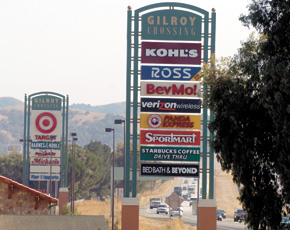Sales tax revenue vary wildly between Gilroy, Hollister and
neighboring jurisdictions
On any given weekend, thousands of cars tool in and out of the
Gilroy outlets as out-of-towners troll the city’s big-box district
in search of the great American bargain.
Sales tax revenue vary wildly between Gilroy, Hollister and neighboring jurisdictions
On any given weekend, thousands of cars tool in and out of the Gilroy outlets as out-of-towners troll the city’s big-box district in search of the great American bargain.
For some residents it’s an unsightly scene, one that mars the once bucolic gateway to the historic Pacheco Pass. But there’s no denying those sprawling outlets bring in a huge chunk of change to city coffers, which, in turn, gives Gilroy residents an inordinate amount of public works projects, including a massive park network, downtown revitalization, not to mention an award-winning sewage facility.
“If it weren’t for sales tax the city of Gilroy would be in a world of hurt, because we all know Proposition 13 doesn’t do anything for us,” said City Administrator Jay Baksa.
The big-box district – in southeast Gilroy along U.S. 101 – isn’t the end-all when it comes to loading up the town’s capital improvement budget, but it sure doesn’t hurt. Consider that sales tax revenue brings in between $10 million and $12 million a year: In fiscal year 2004-05, Gilroy sales tax revenue added up to $12.6 million; in 2003-04 it was $11.5 million, and the year before it was $10.2 million.
You could say Gilroy’s dependency on the outlet centers is a growing proposition.
“For our town, absolutely,” Baksa offered, referring to how the city depends on big-box stores for sales-tax revenue. “And it’s not just big-box, but the retail slant the City Council took on beginning in the early 1990s is paying off.”
Hollister, of course, can’t make such boasts, especially since the state slapped a moratorium on sewage hookups in 2002, thanks to the unconstrained growth that busted a sewage pond. Still, the Hay Capital is able to reap a bit from its own big-boxes – between Target, Rite-Aide, Big K and other retailers: In 2004-05 Hollister took in $3.2 million; in 2003-04 it was $3.7 million. Add another $776,000 or so a year for what bean counters call the state’s “triple flip,” that is, a state reimbursement after state bureaucrats took more than they were supposed to for state coffers, called Senate Bill 1096.
Hollister Finance Director Robert Galvan pointedly targets the building moratorium as a key contributor to Hollister’s fiscal woes.
“You really can’t compare Hollister to Gilroy, which has no [building] moratorium,” Galvan said. “It’s just a timing factor.”
In other words, every dog has its day, and Hollister will once again rise to seize the development brass ring. After all, people living in the 6,900-home city proposed by DMB off Highway 25 – and who knows how many more homes they plan for the nearby O’Connell Ranch – have to shop somewhere.
Considering the six miles that lay between the Gilroy outlets and DMB’s proposed mega-development, is there really any wonder where those folks will by their Nikes or dinnerware?
SEE RELATED STORY: Public projects take a breather










